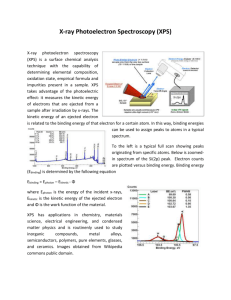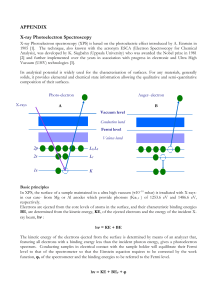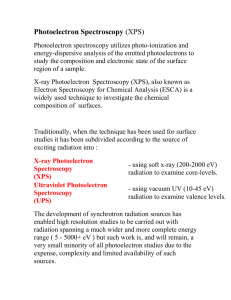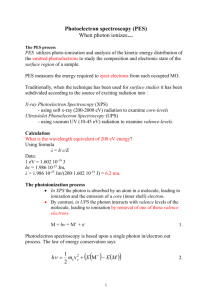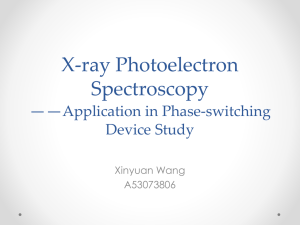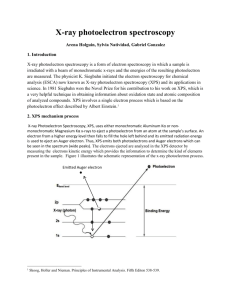ev coupling
advertisement
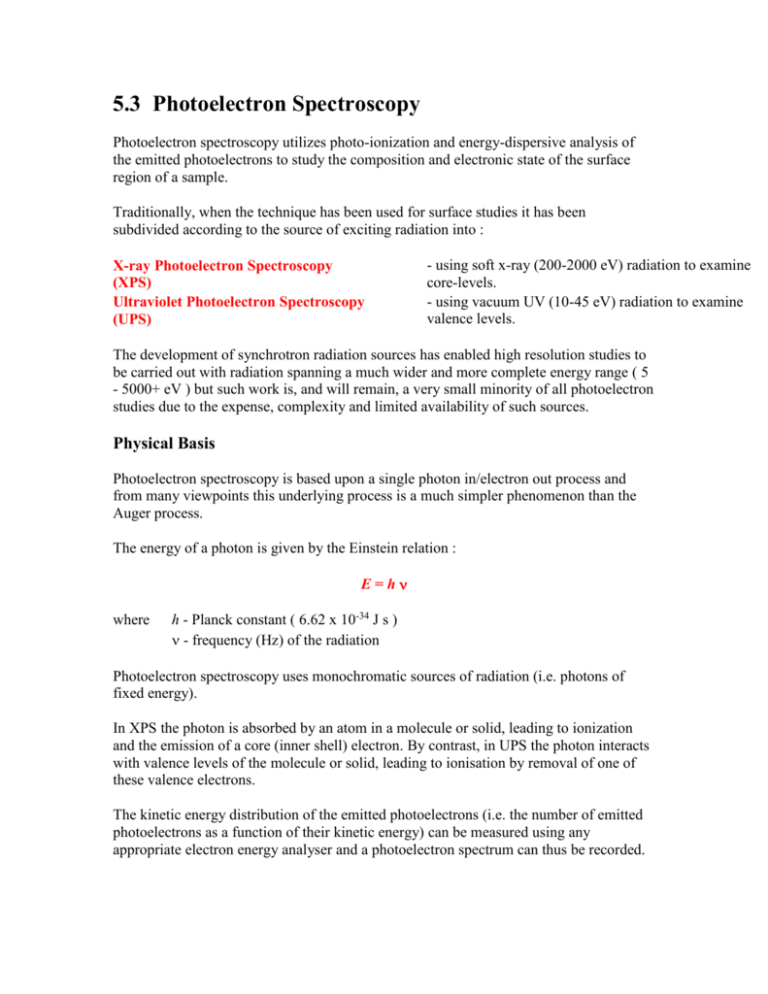
5.3 Photoelectron Spectroscopy
Photoelectron spectroscopy utilizes photo-ionization and energy-dispersive analysis of
the emitted photoelectrons to study the composition and electronic state of the surface
region of a sample.
Traditionally, when the technique has been used for surface studies it has been
subdivided according to the source of exciting radiation into :
X-ray Photoelectron Spectroscopy
(XPS)
Ultraviolet Photoelectron Spectroscopy
(UPS)
- using soft x-ray (200-2000 eV) radiation to examine
core-levels.
- using vacuum UV (10-45 eV) radiation to examine
valence levels.
The development of synchrotron radiation sources has enabled high resolution studies to
be carried out with radiation spanning a much wider and more complete energy range ( 5
- 5000+ eV ) but such work is, and will remain, a very small minority of all photoelectron
studies due to the expense, complexity and limited availability of such sources.
Physical Basis
Photoelectron spectroscopy is based upon a single photon in/electron out process and
from many viewpoints this underlying process is a much simpler phenomenon than the
Auger process.
The energy of a photon is given by the Einstein relation :
E = h
where
h - Planck constant ( 6.62 x 10-34 J s )
- frequency (Hz) of the radiation
Photoelectron spectroscopy uses monochromatic sources of radiation (i.e. photons of
fixed energy).
In XPS the photon is absorbed by an atom in a molecule or solid, leading to ionization
and the emission of a core (inner shell) electron. By contrast, in UPS the photon interacts
with valence levels of the molecule or solid, leading to ionisation by removal of one of
these valence electrons.
The kinetic energy distribution of the emitted photoelectrons (i.e. the number of emitted
photoelectrons as a function of their kinetic energy) can be measured using any
appropriate electron energy analyser and a photoelectron spectrum can thus be recorded.
The process of photoionization can be considered in several ways : one way is to look at
the overall process as follows :
A + h A+ + eConservation of energy then requires that :
E(A) + h = E(A+ ) + E(e-)
Since the electron's energy is present solely as kinetic energy (KE) this can be rearranged
to give the following expression for the KE of the photoelectron :
KE = h - ( E(A+ ) - E(A) )
The final term in brackets, representing the difference in energy between the ionized and
neutral atoms, is generally called the binding energy (BE) of the electron - this then leads
to the following commonly quoted equation :
KE = h - BE
An alternative approach is to consider a one-electron model along the lines of the
following pictorial representation ; this model of the process has the benefit of simplicity
but it can be rather misleading.
The BE is now taken to be a direct measure of the energy required to just remove the
electron concerned from its initial level to the vacuum level and the KE of the
photoelectron is again given by :
KE = h - BE
NOTE - the binding energies (BE) of energy levels in solids are conventionally measured
with respect to the Fermi-level of the solid, rather than the vacuum level. This involves a
small correction to the equation given above in order to account for the work function ()
of the solid, but for the purposes of the discussion below this correction will be neglected.
Experimental Details
The basic requirements for a photoemission experiment (XPS or UPS) are:
1. a source of fixed-energy radiation (an x-ray source for XPS or, typically, a He
discharge lamp for UPS)
2. an electron energy analyser (which can disperse the emitted electrons according to
their kinetic energy, and thereby measure the flux of emitted electrons of a
particular energy)
3. a high vacuum environment (to enable the emitted photoelectrons to be analysed
without interference from gas phase collisions)
Such a system is illustrated schematically below:
There are many different designs of electron energy analyser but the preferred option for
photoemission experiments is a concentric hemispherical analyser (CHA) which uses an
electric field between two hemispherical surfaces to disperse the electrons according to
their kinetic energy.
5.3.1 X-ray Photoelectron Spectroscopy (XPS)
For each and every element, there will be a characteristic binding energy associated with
each core atomic orbital i.e. each element will give rise to a characteristic set of peaks in
the photoelectron spectrum at kinetic energies determined by the photon energy and the
respective binding energies.
The presence of peaks at particular energies therefore indicates the presence of a specific
element in the sample under study - furthermore, the intensity of the peaks is related to
the concentration of the element within the sampled region. Thus, the technique provides
a quantitative analysis of the surface composition and is sometimes known by the
alternative acronym , ESCA (Electron Spectroscopy for Chemical Analysis).
The most commonly employed x-ray sources are those giving rise to :
Mg K radiation : h = 1253.6 eV
Al K radiation : h = 1486.6 eV
The emitted photoelectrons will therefore have kinetic energies in the range of ca. 0 1250 eV or 0 - 1480 eV . Since such electrons have very short IMFPs in solids (see
Section 5.1) , the technique is necessarily surface sensitive.
Example 1 - the XPS spectrum of Pd metal
The diagram below shows a real XPS spectrum obtained from a Pd metal sample using
Mg K radiation
- the main peaks occur at kinetic energies of ca. 330, 690, 720, 910 and 920 eV.
Since the energy of the radiation is known it is a trivial matter to transform the spectrum
so that it is plotted against BE as opposed to KE.
The most intense peak is now seen to occur at a binding energy of ca. 335 eV
Working downwards from the highest energy levels ......
1. the valence band (4d,5s) emission occurs at a binding energy of ca. 0 - 8 eV (
measured with respect to the Fermi level, or alternatively at ca. 4 - 12 eV if
measured with respect to the vacuum level ).
2. the emission from the 4p and 4s levels gives rise to very weak peaks at 54 and 88
eV respectively
3. the most intense peak at ca. 335 eV is due to emission from the 3d levels of the Pd
atoms, whilst the 3p and 3s levels give rise to the peaks at ca. 534/561 eV and 673
eV respectively.
4. the remaining peak is not an XPS peak at all ! - it is an Auger peak arising from xray induced Auger emission. It occurs at a kinetic energy of ca. 330 eV (in this
case it is really meaningless to refer to an associated binding energy).
These assignments are summarised below ...
It may be further noted that
there are significant differences in the natural widths of the various photoemission
peaks
the peak intensities are not simply related to the electron occupancy of the orbitals
Exercise 1 - the XPS spectrum of NaCl
The diagram opposite shows an energy level diagram
for sodium with approximate binding energies for the
core levels.
If we are using Mg K ( h = 1253.6 eV ) radiation ...
... at what kinetic energy will the Na 1s
photoelectron peak be observed ?
(the 1s peak is that resulting from photoionisation of
the 1s level)
... at what kinetic energy will the Na 2s and 2p
photoelectron peaks be observed ?
Spin-Orbit Splitting
Closer inspection of the spectrum shows that emission from some levels (most obviously
3p and 3d ) does not give rise to a single photoemission peak, but a closely spaced
doublet.
We can see this more clearly if, for example, we expand the spectrum in the region of the
3d emission ...
The 3d photoemission is in fact split between two peaks, one at 334.9 eV BE and the
other at 340.2 eV BE, with an intensity ratio of 3:2 . This arises from spin-orbit coupling
effects in the final state. The inner core electronic configuration of the initial state of the
Pd is :
(1s)2 (2s)2 (2p)6 (3s)2 (3p)6 (3d)10 ....
with all sub-shells completely full.
The removal of an electron from the 3d sub-shell by photo-ionization leads to a (3d)9
configuration for the final state - since the d-orbitals ( l = 2) have non-zero orbital angular
momentum, there will be coupling between the unpaired spin and orbital angular
momenta.
Spin-orbit coupling is generally treated using one of two models which correspond to the
two limiting ways in which the coupling can occur - these being the LS (or RussellSaunders) coupling approximation and the j-j coupling approximation.
If we consider the final ionised state of Pd within the Russell-Saunders coupling
approximation, the (3d)9 configuration gives rise to two states (ignoring any coupling
with valence levels) which differ slightly in energy and in their degeneracy ...
2
2
D 5/2
D 3/2
gJ = 2x{5/2}+1 = 6
gJ = 2x{3/2}+1 = 4
These two states arise from the coupling of the L = 2 and S = 1/2 vectors to give
permitted J values of 3/2 and 5/2. The lowest energy final state is the one with maximum
J (since the shell is more than half-full), i.e. J = 5/2, hence this gives rise to the "lower
binding energy" peak. The relative intensities of the two peaks reflects the degeneracies
of the final states (gJ = 2J + 1), which in turn determines the probability of transition to
such a state during photoionization.
The Russell-Saunders coupling approximation is best applied only to light atoms and this
splitting can alternatively be described using individual electron l-s coupling. In this case
the resultant angular momenta arise from the single hole in the d-shell; a d-shell electron
(or hole) has l = 2 and s = 1/2, which again gives permitted j-values of 3/2 and 5/2 with
the latter being lower in energy.
The peaks themselves are conventionally annotated as indicated - note the use of lower
case lettering
This spin-orbit splitting is of course not evident with s-levels (l = 0), but is seen with p,d
& f core-levels which all show characteristic spin-orbit doublets.
Chemical Shifts
The exact binding energy of an electron depends not only upon the level from which
photoemission is occurring, but also upon :
1. the formal oxidation state of the atom
2. the local chemical and physical environment
Changes in either (1) or (2) give rise to small shifts in the peak positions in the spectrum so-called chemical shifts .
Such shifts are readily observable and interpretable in XP spectra (unlike in Auger
spectra) because the technique :
is of high intrinsic resolution (as core levels are discrete and generally of a welldefined energy)
is a one electron process (thus simplifying the interpretation)
Atoms of a higher positive oxidation state exhibit a higher binding energy due to the
extra coulombic interaction between the photo-emitted electron and the ion core. This
ability to discriminate between different oxidation states and chemical environments is
one of the major strengths of the XPS technique.
In practice, the ability to resolve between atoms exhibiting slightly different chemical
shifts is limited by the peak widths which are governed by a combination of factors ;
especially
the intrinsic width of the initial level and the lifetime of the final state
the line-width of the incident radiation - which for traditional x-ray sources can
only be improved by using x-ray monochromators
the resolving power of the electron-energy analyser
In most cases, the second factor is the major contribution to the overall line width.
Examples of chemical shifts
Eg.1 Oxidation states of
titanium [Ti 2p spectra].
Angle Dependent Studies
As described in Section 5.1, the degree of surface sensitivity of an electron-based
technique such as XPS may be varied by collecting photoelectrons emitted at different
emission angles to the surface plane. This approach may be used to perform nondestructive analysis of the variation of surface composition with depth (with chemical
state specificity).
Examples
Angle-dependent nnalysis of a silicon wafer with a native oxide layer
(courtesy of Physical Electronics, Inc. (PHI) )
5.3.2 Ultraviolet Photoelectron Spectroscopy (UPS)
In UPS the source of radiation is normally a noble gas discharge lamp ; frequently a Hedischarge lamp emitting He I radiation of energy 21.2 eV .
Such radiation is only capable of ionising electrons from the outermost levels of atoms the valence levels. The advantage of using such UV radiation over x-rays is the very
narrow line width of the radiation and the high flux of photons available from simple
discharge sources. The main emphasis of work using UPS has been in studying :
1. the electronic structure of solids - detailed angle resolved studies permit the
complete band structure to be mapped out in k-space.
2. the adsorption of relatively simple molecules on metals - by comparison of the
molecular orbitals of the adsorbed species with those of both the isolated
molecule and with calculations.
